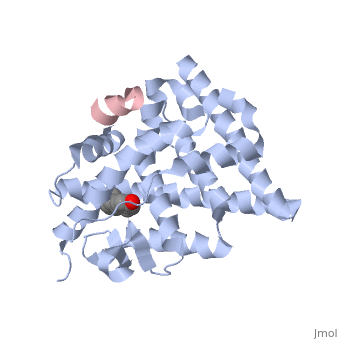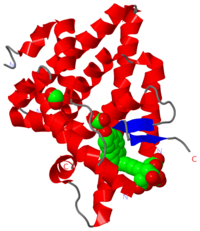Estrogen receptor
From Proteopedia
(Difference between revisions)
| Line 3: | Line 3: | ||
{{Clear}} | {{Clear}} | ||
'''Estrogen receptors''' (ER) are activated by the hormone estrogen (EST). The activated ER binds DNA and regulates the activity of many genes. There are 2 forms of ER: α and β and ER dimers can be of αα, ββ and αβ. ER is composed of 5 domains: N terminal A/B domain can transactivate transcription without binding estrogen; C domain (DBD) binds to Estrogen response elements of DNA; D domain is a hinge region; E domain is ligand binding (LBD) as well as binding the coactivator and corepressor proteins and transactivates gene transcription.<br /> | '''Estrogen receptors''' (ER) are activated by the hormone estrogen (EST). The activated ER binds DNA and regulates the activity of many genes. There are 2 forms of ER: α and β and ER dimers can be of αα, ββ and αβ. ER is composed of 5 domains: N terminal A/B domain can transactivate transcription without binding estrogen; C domain (DBD) binds to Estrogen response elements of DNA; D domain is a hinge region; E domain is ligand binding (LBD) as well as binding the coactivator and corepressor proteins and transactivates gene transcription.<br /> | ||
| - | For more details see [[Ivan Koutsopatriy estrogen receptor]]. | + | For more details see<br /> |
| + | [[Ivan Koutsopatriy estrogen receptor]]<br /> | ||
| + | [[C-di-GMP receptors with PilZ domain]]. | ||
Revision as of 07:37, 31 January 2016
| |||||||||||
3D structures of estrogen receptor
Updated on 31-January-2016
Reference
- ↑ Li MJ, Greenblatt HM, Dym O, Albeck S, Pais A, Gunanathan C, Milstein D, Degani H, Sussman JL. Structure of estradiol metal chelate and estrogen receptor complex: The basis for designing a new class of selective estrogen receptor modulators. J Med Chem. 2011 Apr 7. PMID:21473635 doi:10.1021/jm200192y


